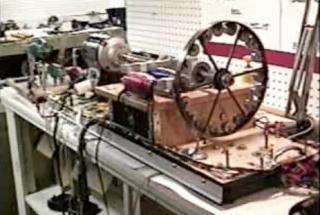February 7, 2008 weblog
Inventor Doesn't Dare Say 'Perpetual Motion Machine'

Thane Heins knows the track record of inventors that claim to make breakthroughs in power generation methods, especially when they claim to defy the second law of thermodynamics. Every so often, a (usually untrained) scientist comes along with a machine that supposedly creates more energy than is put in. Every time, the ideas have been rebuked by real scientists.
That's why 46-year-old Heins, a college drop-out from Ottawa who's been working on his project since 1985, is being very cautious. He is the first to admit that he doesn't know how his machine works from a physics standpoint. He just hopes that someone else might understand.
Last week, Heins demonstrated his machine to MIT professor Markus Zahn, an expert in electromagnetic and electronic systems. It proved interesting enough to stump the professor, as well. But Zahn thinks the idea is worth investigating further. "It's an unusual phenomena I wouldn't have predicted in advance," Zahn told The Toronto Star. "But I saw it. It's real."
In Heins' machine, he explains that magnetic friction somehow gets turned into a magnetic boost. Working with an electric motor, he attached the drive shaft to a steel rotor with small round magnets lining its outer edges. In this set-up of a simple generator, the rotor would spin so that the magnets passed by a wire coil just in front of them, generating electrical energy.
Then Heins did an experiment: he overloaded the generator to get a current, which typically causes the wire coil to build up a large electromagnetic field. Usually, this kind of electromagnetic field creates an effect called "Back EMF" due to the so-called Lenz's law. The effect should repel the spinning magnets on the rotor, and slow them down until the motor stops completely, in accordance with the law of conservation.
But instead of stopping, the rotor began to accelerate. Heins recounts that the first time it happened, the magnets starting flying off and hitting the walls, as he ducked for cover.
The magnetic friction wasn't repelling the magnets and wire coil. Instead, as Heins explains, the steel rotor and driveshaft had conducted the magnetic resistance away from the coil and back into the electric motor. In effect, the Back EMF was boosting the magnetic fields used by the motor to generate electrical energy and cause acceleration.
The faster the motor accelerated, the stronger the electromagnetic field it would create on the wire coil, which in turn would make the motor go even faster. Heins seemed to have created a positive feedback loop. To confirm the theory, Heins replaced part of the driveshaft with plastic pipe that wouldn´t conduct the magnetic field. There was no acceleration.
"What I can say with full confidence is that our system violates the law of conservation of energy," he says. He calls his system "Perepiteia," which in Greek means an action that has the opposite effect of what is intended. But he will leave it to others to decide if the technique can be described as "perpetual motion."
In 2005, Heins formed a company called Potential Difference Inc. to develop and market his invention. He's also been working with researchers from the University of Ottawa on its development, and has demonstrated the machine to several institutions, including the University of Virginia, Michigan State University, the University of Toronto and Queens University.
Heins has also been raising money for his invention, asking individuals such as former U.S. vice-president Al Gore, Virgin Group founder Richard Branson, Tesla Motors chairman Elon Musk, and Google´s "ReCharge IT" project. Due to his obsession with his machine, he has suffered a failed marriage and lost custody of his two children, and is currently unemployed. He doesn´t believe that his idea is a scientific breakthrough of any kind - he just thinks that it deserves to be investigated. MIT´s Zahn agrees.
"To my mind this is unexpected and new, and it´s worth exploring all the possible advantages once you´re convinced it´s a real effect," says Zahn. "There are an infinite number of induction machines in people´s homes and everywhere around the world. If you could make them more efficient, cumulatively, it could make a big difference."
Source: The Toronto Star via Gizmodo




















